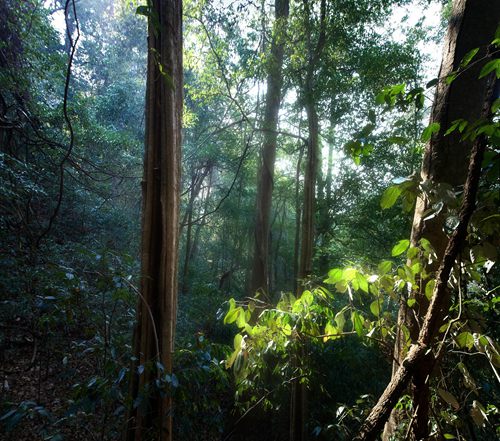Community ecologists frequently debate the relative degree to which deterministic and stochastic processes underpin community assembly. Neutral models of community assembly emphasize the importance of dispersal limitation and demographic stochasticity. Deterministic models of community assembly emphasize the importance of ecological and evolutionary differentiation between species and non-random responses of species to their biotic and abiotic environments. Partitioning beta diversity into environmental and geographic components provides a useful tool for disentangling the relative importance of deterministic or neutral processes in community assembly.
Prof. CAO Min and his team of Xishuangbanna Tropical Botanical Garden (XTBG) conducted a study in the 20-ha Xishuangbanna forest dynamics plot (FDP) located in the Yunnan Province, southwest China (21°36′N, 101°34′E). The study aimed to provide a detailed analysis of the phylogenetic and functional beta diversity on local scales for tropical trees. They focused on quantifying the phylogenetic and functional beta diversity and partitioning their variation along environmental and spatial gradients at multiple scales.
The researchers collected species level functional trait data and generated a molecular community phylogeny for over 400 co-occurring species in the 20-ha plot. They used distribution, environment, trait and phylogenetic data to quantify whether environmental (soil nutrients) distance, geographic distance or their combination were stronger predictors of phylogenetic and functional beta diversity in tropical trees. Furthermore, the researchers compared the phylogenetic and functional beta diversity within and between habitats to determine whether a coarser scale categorical perspective of the environment can provide results comparable to those generated from fine scale continuous representations of the environment.
The study found that the amount of variation in phylogenetic and functional beta diversity explained by environmental distance was consistently greater than that explained by geographic distance. The results provided strong support for a deterministic model underlying the beta diversity. In other words, deterministic processes played a stronger role than stochastic processes in structuring community composition in the diverse assemblage of tropical trees in Xishuangbanna.
The study entitled “Local-scale Partitioning of Functional and Phylogenetic Beta Diversity in a Tropical Tree Assemblage” has been published in Scientific Reports.

20-ha plot in Xishuangbanna (Image by YANG Jie)
Key words
environmental filtering, dispersal limitation, beta diversity, tropical tree assemblage, Xishuangbanna
Contact
LIN Luxiang, Ph.D Principal Investigator
Key Laboratory of Tropical Forest Ecology, Xishuangbanna Tropical Botanical Garden, Chinese Academy of Sciences, Mengla, Yunnan 666303, China
Tel: 86 871 65112637
Fax: 86 871 65160916
E-mail: linluxa@xtbg.ac.cn

